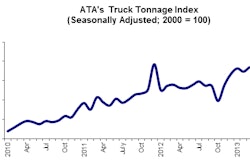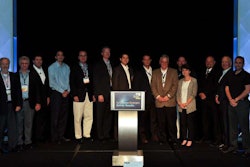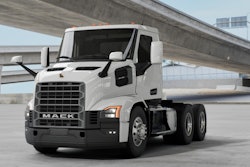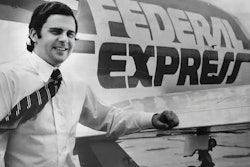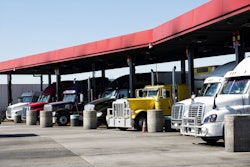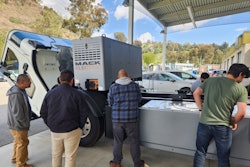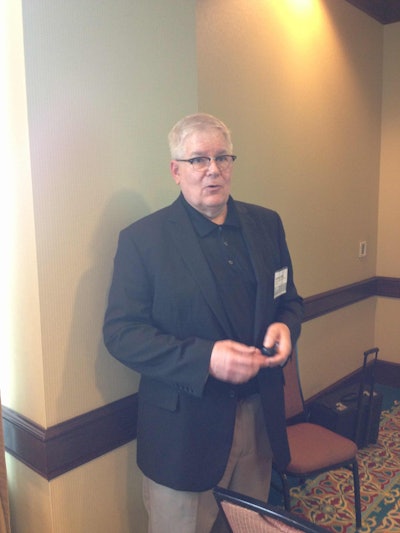 Gordon Klemp spoke to a group fleet executives May 21 in Birmingham, Ala., at the 2013 CCJ Spring Symposium about trends in driver pay.
Gordon Klemp spoke to a group fleet executives May 21 in Birmingham, Ala., at the 2013 CCJ Spring Symposium about trends in driver pay.Nearly half of carriers are offering sign-on bonuses, compared to only 12 percent two years ago, consultant Gordon Klemp told trucking fleet executives today during the 2013 CCJ Spring Symposium in Birmingham, Ala.
Bonuses range from $250 to $5,000 for solo drivers and $2,000 to as much as $15,000 for teams, said Klemp, principal with the National Transportation Institute.
“Recruiters say bonuses are here for the forseeable future,” Klemp said. All bonuses are job- or location-specific, with bonus amounts varying by supply and demand.
Increases in base pay are less likely, Klemp said. Although driver and owner-operator pay in all segments – dry van, refrigerated, flatbed – increased slightly year-over-year in the fourth quarter of 2012, current freight rates do not support further increases. One caveat: Carriers who haul high-value freight may see rates go up enough so that “they may be able to grow their fleets by giving a little of those increases back in pay,” he said.
In the fourth quarter, year-over-year dry van pay increased just 1.1 percent to an average 36.5 cents per mile, Klemp said. Refrigerated driver pay increased 0.6 percent to 34.7 cpm. However, refrigerated drivers’ median annual pay was higher than dry van – $47,721 versus $46,614 – due to more consistent miles and better detention pay, Klemp said.
“Refrigerated has been very stable. Drivers were able to maintain their income even during the economic dip,” he said. Flatbed pay ranked highest, at 38.9 cpm. It also saw the greatest year-over-year increase, 1.3 percent, and the highest median annual pay at $48,931.
Owner-operator rates also increased slightly year-over-year, with median dry van rates increasing 2 cents to 92 cpm. The highest paying dry van carriers are in the Northeast, where “we’ve seen a number of carriers paying $1.02 to $1.05 per mile,” Klemp said. Owner-operators hauling refrigerated freight saw their rate increase 1 cent to 93 cpm. Flatbed owner-operator rates improved to 95 cpm from 94 cpm in fourth quarter 2011. These numbers do not include fuel surcharges, Klemp said.
The gap between what owner-operators and company drivers make is narrowing, Klemp said. “If you looked at it rationally, you’d see it’s not much more money for the risk and effort to become an owner-operator.” And it’s becoming more difficult to become an owner-operator – at least without the help of a carrier.
Carriers face an increasingly difficult task in finding qualified drivers and owner-operators from a pool that’s shrinking due to a variety of factors, Klemp said, including generous unemployment pay that may encourage some drivers not to find jobs until their benefits run out. He also pointed to the “underground economy,” where drivers can plow snow, mow lawns or do other work for cash that isn’t reported as income for tax purposes.
At the same time, with more part-time jobs being created in the current economy, drivers can work two or three jobs and make enough money to allow them to stay home instead of going back on the road.
The shortage of qualified drivers will only get worse: In the next 10 years, 25 percent of today’s drivers will retire or leave due to a physical issue, Klemp said.
As finding new drivers becomes more difficult, carriers are looking at ways to improve driver retention, such as using productivity pay based on performance measures: on-time, preventable accident, equipment utilization, roadside inspection results, miles per gallon and idle time, among others. “These carriers understand that if the driver does this for me, I can do this for them,” Klemp said, but “it takes a fair amount of time to build your model to get the result you expect.”
For example, Classic Carriers, Versailles, Ohio, has had good results using a guaranteed pay program to retain drivers, said Ed Ruhe, vice president of operations/sales, who attended Klemp’s presentation. If a good-performing driver typically makes $900 per week and that drops on a given week, perhaps because of lower miles, Classic raises the driver’s pay up to the usual $900.
“We mark it on his pay check as a ‘management adjustment,'” Ruhe said. When Classic instituted this program in 2000, turnover dropped to 25 percent and has stayed there.





